| Home | Nature Weekly Index |
23 July 2017 | Liverworts and Mosses |
Last weekend, after checking up on the status of the hawk moth caterpillars, I continued with a short walk in the park. This park originally had a large opened green area connected to one of its flank but had since been cleared about 2 years back for construction of houses. The few blocks of new HDB flats will be ready for occupancy soon. With the expected increase of human population in the area, it is going to put a strain on the park's nature inhabitants.
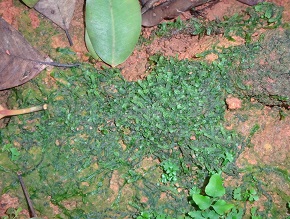
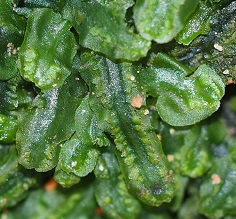 I went back to the spot where I found my first
liverwort (Pallavicinia lyellii) in May to try my luck on locating
the fertile female plant. But after straining my back bending down and my eyes scanning the tiny spread of the liverwort, I
could not find anything that resembled the female structure. Liverwort is considered an ancient plant that produce spores
rather than seeds. In term of botanical classification, it is placed together with mosses and hornworts, collectively known
as bryophyte.
I went back to the spot where I found my first
liverwort (Pallavicinia lyellii) in May to try my luck on locating
the fertile female plant. But after straining my back bending down and my eyes scanning the tiny spread of the liverwort, I
could not find anything that resembled the female structure. Liverwort is considered an ancient plant that produce spores
rather than seeds. In term of botanical classification, it is placed together with mosses and hornworts, collectively known
as bryophyte.
Talking about mosses, there were plenty of them in my pots. I had always wanted to take their pictures but was limited by the photographic equipment in my possession then. With their miniature sizes, it was almost impossible to take any good pictures with a standard compact camera. After acquiring a micro lens and other relevant equipment in January, I tried it on the mosses but it was still kind of difficult especially on the erected sporophyte (fertile structure) that consist of a hair-like stalk (seta) and a tiny capsule at the top end.
The pictures below were some of the mosses found in my pots. After browsing through the pocket guide on Mosses of Singapore published by the Science Centre, I suspect one of them (first row of the pictures below) might be Isopterygium bancanum. The thread-like structure in the second picture from the left might be the protonema, an early stage of the moss's life cycle. However, there was another species Isopterygium minutirameum mentioned in the guide book that looked very similar to Isopterygium bancanum.
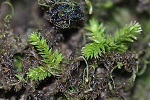

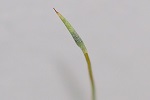

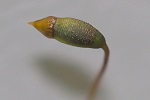
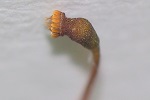
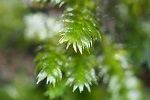

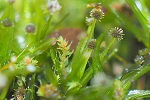 There was another moss (2 pictures on the left) that looked different to the one shown above based on the fertile
structure. Its stalk was shorter by a third and the capsule was not perpendicular to the stalk. It might be a
Fissidens species. One other moss (picture on the right) might be a Calymperes species which showed a spiny
spherical structure (gemma) attached to the tip of some leaves.
There was another moss (2 pictures on the left) that looked different to the one shown above based on the fertile
structure. Its stalk was shorter by a third and the capsule was not perpendicular to the stalk. It might be a
Fissidens species. One other moss (picture on the right) might be a Calymperes species which showed a spiny
spherical structure (gemma) attached to the tip of some leaves.
There should be a few more species of mosses in my pots. I will have to find some ways to take clearer pictures of them if I wanted to have a chance on identifying them.